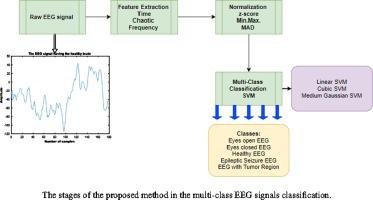IRBM ( IF 5.6 ) Pub Date : 2020-07-08 , DOI: 10.1016/j.irbm.2020.06.008 K. Polat , M. Nour

|
Objectives: Epileptic seizures are one of the most common diseases in society and difficult to detect. In this study, a new method was proposed to automatically detect and classify epileptic seizures from EEG (Electroencephalography) signals.
Methods: In the proposed method, EEG signals classification five-classes including the cases of eyes open, eyes closed, healthy, from the tumor region, an epileptic seizure, has been carried out by using the support vector machine (SVM) and the normalization methods comprising the z-score, minimum-maximum, and MAD normalizations. To classify the EEG signals, the support vector machine classifiers having different kernel functions, including Linear, Cubic, and Medium Gaussian, have been used. In order to evaluate the performance of the proposed hybrid models, the confusion matrix, ROC curves, and classification accuracy have been used. The used SVM models are Linear SVM, Cubic SVM, and Medium Gaussian SVM.
Results: Without the normalizations, the obtained classification accuracies are 76.90%, 82.40%, and 81.70% using Linear SVM, Cubic SVM, and Medium Gaussian SVM, respectively. After applying the z-score normalization to the multi-class EEG signals dataset, the obtained classification accuracies are 77.10%, 82.30%, and 81.70% using Linear SVM, Cubic SVM, and Medium Gaussian SVM, respectively. With the minimum-maximum normalization, the obtained classification accuracies are 77.20%, 82.40%, and 81.50% using Linear SVM, Cubic SVM, and Medium Gaussian SVM, respectively. Moreover, finally, after applying the MAD normalization to the multi-class EEG signals dataset, the obtained classification accuracies are 76.70%, 82.50%, and 81.40% using Linear SVM, Cubic SVM, and Medium Gaussian SVM, respectively.
Conclusion: The obtained results have shown that the best hybrid model is the combination of cubic SVM and MAD normalization in the classification of EEG signals classification five-classes.
中文翻译:

基于新型脑电信号混合模型的癫痫发作检测
目的:癫痫发作是社会上最常见的疾病之一,难以发现。在这项研究中,提出了一种新方法来自动检测和分类来自脑电图(脑电图)信号的癫痫发作。
方法:采用支持向量机(SVM)对脑电信号进行分类,包括从肿瘤部位睁开,闭眼,健康,癫痫发作等五种脑电信号分类。包括z得分,最小最大和MAD归一化的方法。为了对EEG信号进行分类,已经使用了具有不同核函数的支持向量机分类器,包括线性,三次和中等高斯函数。为了评估所提出的混合模型的性能,使用了混淆矩阵,ROC曲线和分类精度。使用的SVM模型是线性SVM,三次SVM和中高斯SVM。
结果:如果不进行归一化,则使用线性SVM,三次SVM和中高斯SVM所获得的分类精度分别为76.90%,82.40%和81.70%。将z分数归一化应用于多类EEG信号数据集后,使用线性SVM,三次SVM和中高斯SVM分别获得的分类精度分别为77.10%,82.30%和81.70%。通过最小最大归一化,使用线性SVM,三次SVM和中高斯SVM所获得的分类精度分别为77.20%,82.40%和81.50%。此外,最后,将MAD归一化应用于多类EEG信号数据集后,使用线性SVM,三次SVM和中高斯SVM分别获得的分类精度分别为76.70%,82.50%和81.40%。
结论:获得的结果表明,最佳的混合模型是三次SVM和MAD归一化相结合的脑电信号分类五类。











































 京公网安备 11010802027423号
京公网安备 11010802027423号